Uniqueness of artistic phenomena and their process
The character of artistic formation and exhibition organisation in the 1980s Poland were given numerous publications and conferences. Generally, these texts emphasise the aftermath of attitudes and stylistic trends shaped during the period that were growing in the following decades of Polish art growth. Their traces are still to be found even now, in the image of the present artistic panorama. The abundancy of artistic events in that decade would create an impression as if they were a single and coherent phenomenon, distinguishable from vernacular contemporary art. Given these facts, one may rightfully pose a question: what are the components constituting the uniqueness of this artistic decade? None of the classified trends in the art history lived in a vacuum, beyond a specific artist or a group. They are ingrained in pursuit of creative independency as well as the intention to manifest one’s own expression through an intended medium. It can be concluded – though bearing in mind this might be an oversimplification – that such synergic comparison let us speak about art understood as a broader process, affecting society in an evident fashion.
A number of factors influenced said process: historical and sociological circumstances, the organisational structure as well as the culture institutions management system, and, most importantly, the creators themselves. On the macro and micro scale, curators, art dealers, gallery owners, all exponents and artistic event’s organisers are given the key role of intermediaries. A chain of dependency like this could be presented in reverse order. Regardless of the details however, it is only due to coupling of indicated elements that real artistic phenomena occur in public awareness. Such generally formulated thesis is reflected in the tiny little fragment of Polish art growth during the decade of the ‘80s. The purpose here is to outline the context and indicate the prominent exhibitions, as well as the people shaping this phenomenon, with the ultimate aim to present the character of the artistic activity in 1980s Poland.
The lost decade? Complex of the West and apparent regression
Assessing the growth of Polish art of the ‘80s, an evident comparison to the so called West situates it in terms of artistic achievements. Juxtaposing levels of different countries’ cultural growth is by all means a natural formula to shape the knowledge about the culture of any period, though there is a ranking function as well. For instance, Krzysztof Stanisławski claims that Polish art of the ‘80s was rebellious in its expression. He compares the objection in visual arts raised towards the existing state of reality to drives similar to the ones exhibited by the Dadaist movement[1]. Considering the context of Sopot exhibition entitled “The ‘80s Expression”, the critic assures its painting mastery level is equal to works of neo-expressionistic “Neue Wilde” group. At the same time, he notes the secondary character of Polish artists in light of their previous work and faults them with utter “passive imitativeness” of the long gone and out-of-date western tendencies. Interestingly, as pointed out the six years’ period between 1980 and 1986, separating the peak of the activity of the aforementioned group and Polish exhibition in Sopot, can be deemed almost an epoch given the dynamic growth in contemporary art[2]. This peculiar backwardness is observed by Krzysztof Załuski who believes that this six years’ time feels like an entire artistic epoch of swirling concepts that reached us too late[3].
An extreme opinion on this matter, from the contemporary perspective, is shared by Stefan Starzyński. In so many words, he states that the ‘80s in Poland are justifiably viewed a “lost decade” in an artistic sense. The situation resulting from the martial law introduction and its long-range consequences had disconnected Poland from attitudes represented by foreign countries as much as their influence. Thus, according to the critic, it led to explicit opportunism and ideology-based approach; both in following the official direction established by cultural policy of the country, as well as attempting to bind artistic work with the church institution. In his concluding remarks, Starzyński’s describe the state of contemporary Polish art as most vivid while other countries’ artistic cultures and their efforts were suddenly the object to pursue by Polish creators at the end of the ‘80s. Such an evaluation has a reference point in an exhibition devoted to the art of this short period, organised between 2021 and 2022 in Viennese “Albertina Modern”, that drew attention to the explosion of artistic phenomena on a global scale[4].
“The ‘80s. Art of the Eighties” exhibition that author discusses here indeed showed richness and formal versatility. The works were placed in thirteen rooms, with their number and thematic subdivision reflecting the artistic phenomena scale of that decade. In official press release, the ‘80s were described as a period of anticipation for neoliberal ideas and increasing globalism that pushed further the economic and cultural exchange borders. In the West, this time is associated with rapid growth in computer technologies accompanied by boom for new forms of entertainment resulting from said advancement, as well as changes in visual media comprised of many strands, not a single coherent vision. The sequence of these phenomena produced an outcome in form of consumptionism; such was the atmosphere Western artists were shaped by, on the one hand gaining benefit from it and on the other expressing criticism towards some of its aspects in their artworks.
The organisers emphasise that the exhibition’s concept is shown from the perspective of Anglo-Saxon environment, Germany, Austria and Italy, aspiring for a diversified overview of the decade’s art[5]. The artists involved reveal post modernistic strategy of quotation, resorting to practice, especially through the use of mass media aesthetics, mixing the lofty and the lowly, reflecting existence in the reality of omnipresent images[6]. Graffiti gradually becomes obsolete and gives way to a new trend of street art – as it is called these days – a phenomenon based on social commentary[7]. The exhibition featured paintings of distinguished individuals such as: Jean-Michael Basquiat, Keith Haring, Francesco Clemente or Julian Schnabel. Furthermore, one could see Cindy Sherman’s, Robert Longo’s, or Gilbert & George’s photographies, as well as Jeff Koonsal’s sculptures and neon installations of Jenny Holzer, Bridgette Kowanz and Bruce Nauman. The above observations lead to the conclusion that juxtaposing such diversified environments shaping their artists through different circumstances brings a sense of incommensurability. This matter does not concern the USA or Italy alone, but Germany as well, as the original artistic search formed more in West Germany (FRG), the capitalistic sphere of influence in that part of the world, on the other side of so-called “the Iron Curtain”.
It is obvious that given such a comparison, Polish artistic work may appear hidebound. Nevertheless, according to Jarosław Daszkiewicz, with the beginning of the ‘80s many artists from Poland tried to escape beyond institutional mainstream and their formal search became one with apparently developing neo-expressionism trend. However, the martial law in 1981 did not allow this art to be more accessible for different countries and confront similar findings. A situation like this formally isolated Polish artistic work from the western influence, leading to a sudden transition into the art world undergoing the next phase of change. While Polish situation was relatively stabilizing, and there was a revival of the expressionistic formula, at the same time, creators from the mentioned countries adopted realism elements into the composition or turned to the language of abstraction. Still, in Daszkiewicz’s view, Polish art excelled when compared to the Western one, and the works of domestic artists displayed in the second half of the 1980s were gaining favour abroad – partly due to previously dominant style’s creative transformation[8]. Regardless of how relevant was Polish art in the light of global tendencies, turning to painting as medium was a common trend. In the catalogue to Arsenal 88’ (Arsenał ‘88) exhibition, Mariusz Rosiak calls it “conversion to painting”[9] and Andrzej Betel, referencing another exhibition, writes about “new Polish painting”. The style of this new painting had its own character, though as expressed by Bertel, it was slightly nihilistic and ironic[10].
A wind of change for art
In line with the previous conclusion, if one was to deem Polish art as unique and not plain backward in its development, socio-political factors connected with our creative environment’s situation should be, compendiously at least, included. Among the most critical of the events were: Polish trade union “Solidarity” establishment in 1980, the martial law introduction and consequent Association of Polish Artists and Designers [henceforth written as Polish acronym, ZPAP – translator’s note] resolution in 1984; a body later replaced with Polish Graphic Designers and Painters Department of Arts. As far as culture management was concerned, there were important personnel changes in institutions such as “Zachęta Gallery”. A long neglected and planned to be demolished Ujazdowski Castle became Warsaw’s Centre for Contemporary Art. Yet, one has to wait to visit the place as the formal decision to establish the institution was made in 1982 and its final inauguration took place in 1986. It took couple of years to formulate the institution’s legal status and prepare the run-down place to serve its new function. At that time, the process of collecting analogue as well as digital documentation commenced[11]. Additionally, Videoteka had its humble beginnings, initially including only a dozen or so films about works of distinguished contemporary artists[12].
Coming back to ZPAP, at the moment of its resolution it was a potent association consisting of twelve thousand members; it owned service and manufacturing company ART with its workshops, printing houses, shops and galleries as well as labour and holiday apartments[13]. As to the reason why authorities made the decision to close it down, it was ZPAP’s support towards “Solidarity” which was commented on as “consistent anti-state activity carried out by ZPAP”[14]. Karol Czerajek, director of Visual Arts Department of Ministry of Culture and Arts, gave another reason why association was resolved: allegedly, they did not protect the interests of affiliated artists and artistic matters but instead, there was an emphasis on anti-socialist activity[15]. At the same time, there were voices of those actively involved in the artistic environment saying that ZPAP was a relic, sunk deeply within state structures. Paradoxically, consequences that ensue after association members protested became a catalyst in forming a stance on official culture[16].
The necessity to bring changes to artistic life organisation was first seen at the beginning of the ‘80s, a testament to which is a unique texts under illustrious title “The report on the state of criticism” where three critics referred to the previous decade as, in their opinion, still influential in times contemporary to them. Despite the title, the authors addressed not only the way one writes about art but they also included a broader context of art school education condition, the situation in art institutions and organisations. Along came the criticism of conformism, artists’ career-driven approach and cultural politics opportunism in visual arts. They showed that promoting art is a part and parcel of state propaganda apparatus and, as a result, the artistic life was not subject to growth but stagnation. Furthermore, they brough the lack of contemporary art museums in Poland into attention – a fact that isolated the country on the international arena[17]. Though the following years brought signifcant improvement to many of the described aspects of the artistic life, there were still critics who postulated an explicit correlation between the way the art grew and politics. According to Bogdan Klich – who outlined the situation from the perspective of decade’s end – the culture was subject to politics. Nonetheless, the author refers to both People’s Republic of Poland reign as well as artist associations with the church – the rising patron of the arts[18] on a par with state authorities.
Modern sacrum
The specifics of the artistic environment of that decade are characterised by phenomena called “church exhibitions” – initially combined with an attempt to find an alternative to being part of state structures institutionalisation. A trend of artists turning to the church is observed as a response to Polish crisis of 1981 caused by censorship, both political and mental in nature. In time, it was that sacred institution that took upon itself being the patron of the contemporary arts and exhibition organiser, bringing back to life the artistic activity once more. According to Wojciech Włodarczyk, young artists often treated cooperation with the church structures as means to launch their careers, become recognised at the beginning of their artistic path. In the critic’s view, such action led to loss of artistic autonomy as well as having no particular selection process. This resulted in expositions consisting of too many works varying much in their quality[19]. Naturally, most collected works were displayed as temporary exhibitions in buildings owned by parishes, not in the churches themselves. Still, as put bluntly by Jerzy Nowosielski, religious themes mixed in a rather simplistic manner with national martyrology[20].
Over time though, works of young generation artists leaned more towards experimentation, inevitably becoming a root cause for creating tensions by reflecting spiritual search of a more universal character and deviating much from the Catholic doctrine. Yet, in Aleksander Wojchowski’s assessment, it does not change the fact that contemporary artists came closer to the church, driven by the visceral need[21]. Regardless of intentions, there were voices sceptical towards exhibitions in independent culture circles – especially because they were built around national-martyrological concepts. It was seen solely as a “passing state” syndrome which does not ensure long-lasting narration for the time when there is neither need nor place for such content and stylistics in a changing society[22].
This fear has its grounds, though assessing the artistic movement through the prism of those years makes a more complex image elusive. Even when considering church exhibitions mentioned above, despite the dominance of specific themes and media, there was still enough place for innovativeness and diversity which one can see in particular works. Therefore, animation of creative activities brought some freshness albeit with results varying in quality. Thus, in spite of discrepancies, both worlds created a synergy that carried a sense of purpose and motivation for artistic growth. An attempt to cooperate in order to combine the traditional, current form of expression with that of church tradition was an alternative for state structures. The creators, as it always happens over time, had to function within established boundaries defined by the authority of the institution, yet, with a potential to begin a dialogue without the need to search for loopholes in oppressive-like political system.
The time of revival and its initiators
The exhibition movement went beyond „church displays” and safe solutions dictated by major institutions’ culture politics. Opening new galleries along with the arrival of new initiators trying to make a difference after years of stagnation caused by the martial law – all of this was indicative of time for Polish visual arts’ recovery. The cooperation of said galleries with alternative rock bands, “Dezerter” rehearsals in Dziekanka or “Izrael” performances in Repassage for instance, were a testament to this rebellion. There were several broad-reception exhibitions that relevantly influenced the shape of artistic life in the years to come. The exhibition called “The Eighties’ Expression”, organized in Sopot’s BWA [Polish acronym for Artistic Exhibitions Bureau, henceforth used in the text as BWA – translator’s note] in 1986, though with a significant delay, was indeed an event that opened up Polish artists to the West. As many as 1500 pieces were presented, and the curator of this impactful exposition was Ryszard Ziarkiewicz. The following year his next, large-scale initiative was “Radical realism, concrete abstraction: art in the second half of the 80's” [23][24].
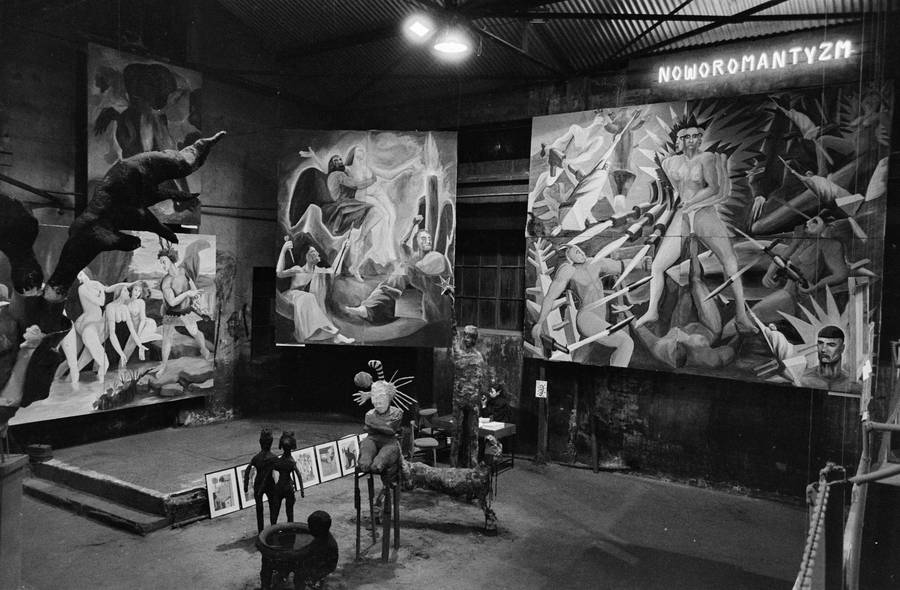
Wystawa Co słychać, dawna Fabryka Norblina, fot. Zygmunt Rytka
As explained by Ziarkiewicz in the exhibition’s catalogue, the intention of the display was to return to artistic tradition and juxtapose plebeiainism and barbarity with high, aristocratic spirit of the art. He highlights the fact that due to presented art human rises above into a superindividual dimension[25].
The exhibition took place in the halls of the National Museum in Warsaw and as far as its reception is concerned, special attention was given to the contrast between expressionistic works in “Neue Wilde” spirit and classical, sterile museum space[26]. Accurately compared to “What’s Up” (“Co Słychać”), an exhibition taking place in the same year, far from being white cube sterile thanks to the place where the works were exhibited – the old factory halls of Norblin.
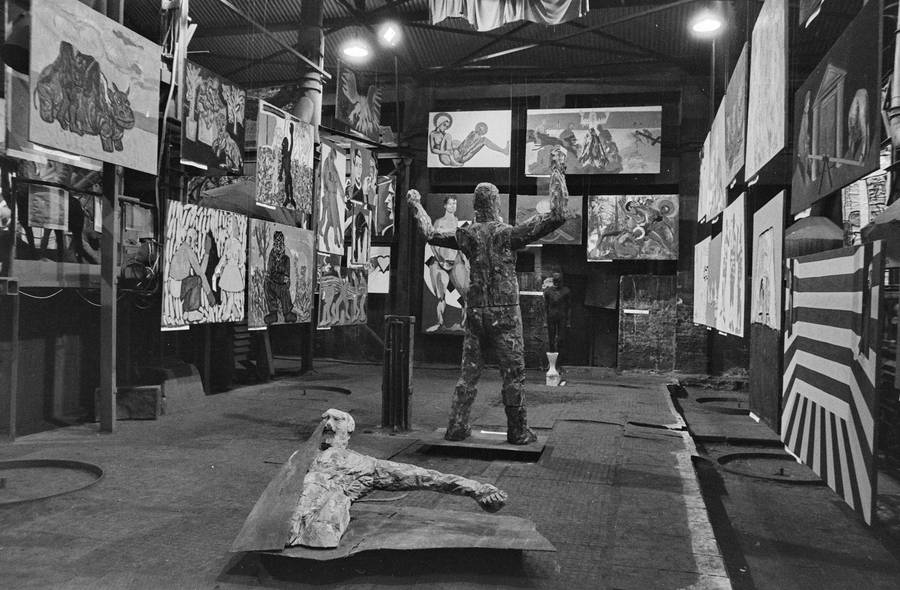
Wystawa Co słychać, dawna Fabryka Norblina, fot. Zygmunt Rytka
Contrasting these two exhibitions in this regard, one of the then critics emphasises the impression of intense clarity resulting from choosing less standard exposition surroundings. Though, essentially in both places, the style of presented works originated from the same source – the German expressionism [27]. Initially, the exhibition was to be held in Zachęta National Gallery of Art[28], a fact that adds greatly to the significance of the place. In terms of quality, Barbara Rogalska stressed the visual formula freshness and content universality in her review on exhibited pieces. Interestingly, she did so by distinguishing it against martyrological works of the previous decade[29].
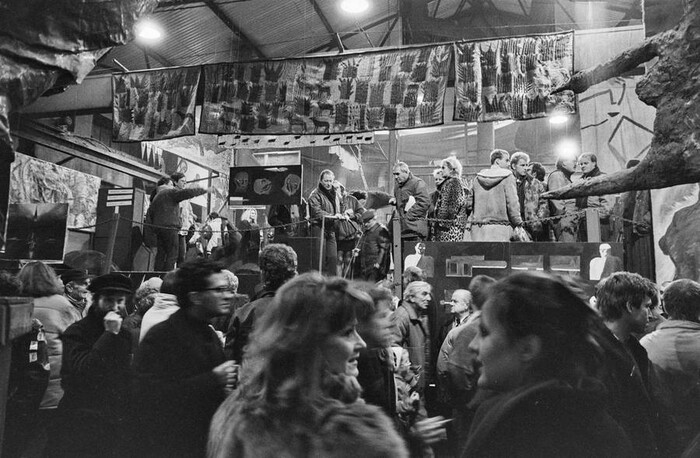
Wystawa Co słychać, dawna Fabryka Norblina, fot. Zygmunt Rytka
Indeed, upon looking at the photographs documenting the exhibition, a pronounced, expressive form, not limited by the space of the walls is to be seen; huge canvas with sculptures and installations placed in various spots did harmonise with monumental, industrial space of the plant. The pieces were stylistically coherent and fit the neoexpressionistic formula seen in Ziarkiewicz’s exhibitions as well. Yet, a curious and a separate differentiator came in the form of presently well-known video “How To Train Little Girls” (“Jak tresuje się dziewczynki”) by Zbigniew Libera, associated more with the “critical art” trend that emerged a decade later. The exhibition in question was housed by another charismatic animator and a representative of visual arts movement in those years – Andrzej Bonarski. In this particular example, his efforts were supported by Maryla Sitowska who was operating in the National Museum in Warsaw and considerably contributed to centering the exposition around youngest generation creators. Bonarski was a collector and a populariser of contemporary Polish art, immensely active due to organization of 23 exhibitions between 1986 and 1991. Focusing his attention on so-called “new expression” painting as well as being encouraged by Sopot’s BWA exhibition, he started his own activity in this area; in the early period, he displayed paintings of Maciej Dowgiałła (nie jestem pewien pisowni - tłumacz) or Jarosław Modzelewski, among others. Bonarski was known for his flexibility in organisation matters, on the one hand relying on the network of private contacts he formed over the years, on the other, he invited TV journalists in order to attract publicity. His activity was motivated by sheer intention to promote the contemporary art leaving behind a limited circle of critics, scholars and creators. He accurately forecasted changes of sentiments in the society, connected with the rise of so-called “middle class”, which meant that a new approach in contemporary art is required[30]. Such dynamics signalled an evolution in broadly understood art market and within major institutions that was gradually taking place at the beginning of the next decade. Opening up to fresh art, investing in it and publicising it beyond the limited circles of specialists shaped creators-organisers-receivers relations anew.
Under the same banner
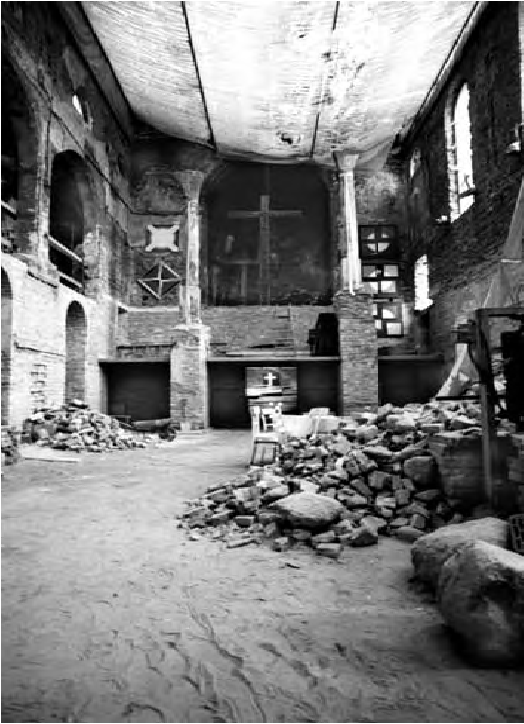
Wystawa Znak Krzyża, fot. Piotr Życieński, z tekstu: Żytnia, kto o tym pamięta
A prominent figure related with revival of exhibition initiatives was Janusz Bogucki who along with Nina Smolarz created a duo of capable organisers. Exhibitions they arranged were strictly connected with the phenomenon of artists-church cooperation mentioned above. In this context, both of them became distinctive and singular individuals. At the same time, Janusz Bogucki’s ideas are an interesting counterpoint for these two main “formateurs” of artistic life.
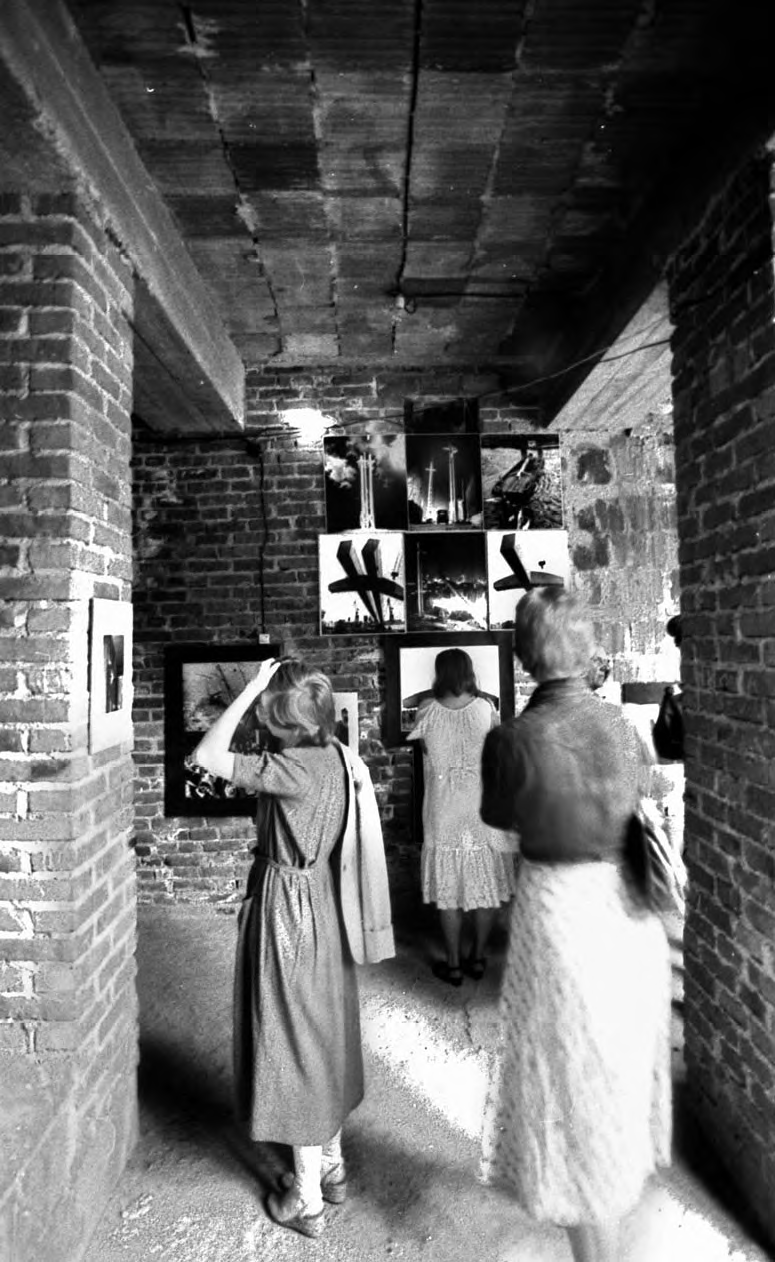
Wystawa Znak Krzyża, fot. Piotr Życieński, z tekstu: Żytnia, kto o tym pamięta
Describing his activity, Bogucki tried to avoid the term “exhibition”, alternatively using such definitions as: “organising space”, “mental space” or “iconosphere creation”[31]. One of the crucial displays was “The Sign of the Cross” (“Znak Krzyża”), 1983, whose main purpose, according to the author, was to “show the presence of the cross in art and life”. The area chosen for the purpose of the exhibition was the derelict church of Divine Mercy which, at the time, was undergoing debris removal.
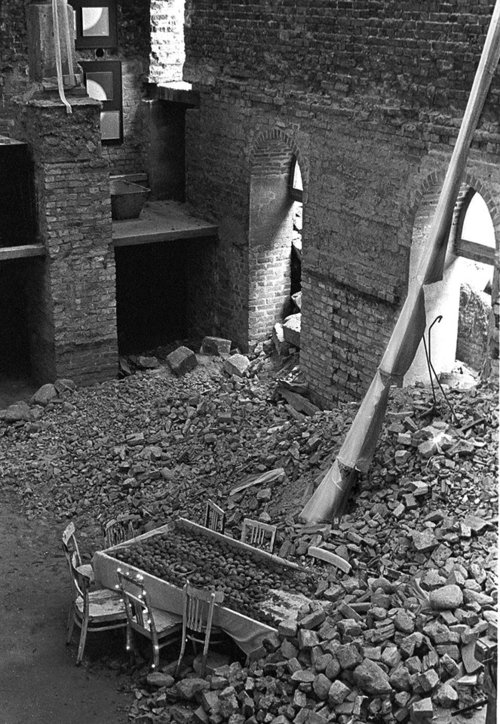
Wystawa Znak Krzyża, Ostatnia wieczerza, fot. Erazm Ciołek
It was there, where Jerzy Bereś, Edward Krasiński and Andrzej Matuszewski, as well as others, presented their installations. The last mentioned artist incorporated the main exhibition theme in a miscellaneous way – he proposed to put together a blue chair with a cross made of rag. On the other hand, Teresa Murak showed her cross sown with cress[32], a motif permanently associated with her artistic activities from the very beginning. Likewise, we can see Jerzy Kalina’s installation entitled “The Last Supper” (“Ostatnia Wieczerza”) in this very context: chairs are placed against debris in the ruined part of the temple, with three planks wrapped in a textile, imitating a table. Equally meaningful installation was “Dedicated to the memory of Grzegorz Przemyk” by Wacław Borowski, presented in a form of a draped textile hovering above the ground like a metaphorical epitaph.
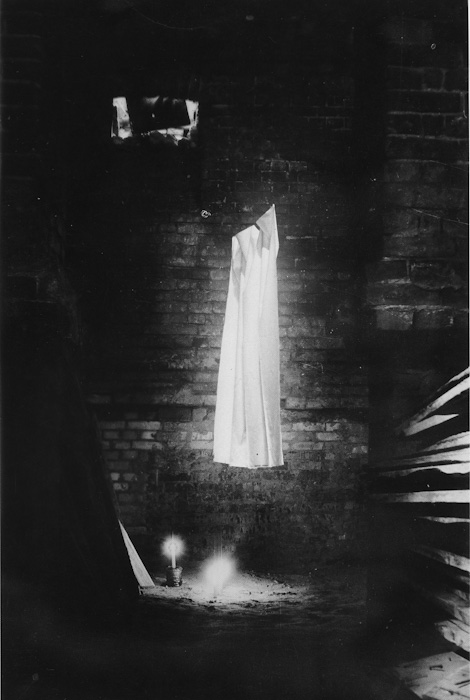
Wystawa Znak Krzyża, Praca dedykowana pamięci Grzegorza Przemyka, z archiwum MSN
In addition, there are photographs showing different angles of cross monuments displayed on the church’s brick walls, intertwined with numerous abstract compositions by Henryk Stażewski and Stefan Gierkowski. Despite the media diversity and location – consistent with the subject of the exhibition – according to Nawojka Cieślińska the cross motif, a base for the artists, received a rather laconic treatment. It was depicted in paintings as a cross of lines, for many artists being a “little trademark”, used more like a “motto from an art competition”[33]. Yet, the works synergistic and fitted in the environment manage to capture genius loci of derelict sacral space on a stylistic and iconographic level. It is worth mentioning that, in its brave approach and the scale of the undertaking, “The Sign of the Cross” preceded Bonarski’s “What’s Up”. “The Sign of the Cross” was not restricted solely to the exhibition with over a hundred visual artists participating, lasting more than a dozen days. It was more than that – an artistic event involving theoreticians giving lectures, actors, composers, musicians and vocalists performing at various shows. From that moment on, the area of the derelict temple had been vivified and used as space for many creative initiatives that were held there in the following years, becoming truly a “cultic” place. Despite its actual state, the church performed liturgical functions. The organisation of events focused around “The Sign of the Cross” was actively supported by the parish priest whose intention was to revitalise the building[34]. Taking the amount of collaborative work into account, one can see community activities that were so important for Bogucki. In Dorota Jarecka’s view, these actions combined his prosocial attitude with Catholic ideas, as testified by his previous activity in favour of promoting art in various institutions and meetings for artistis and critics he organised in Łaski monastery[35].
Community and processuality
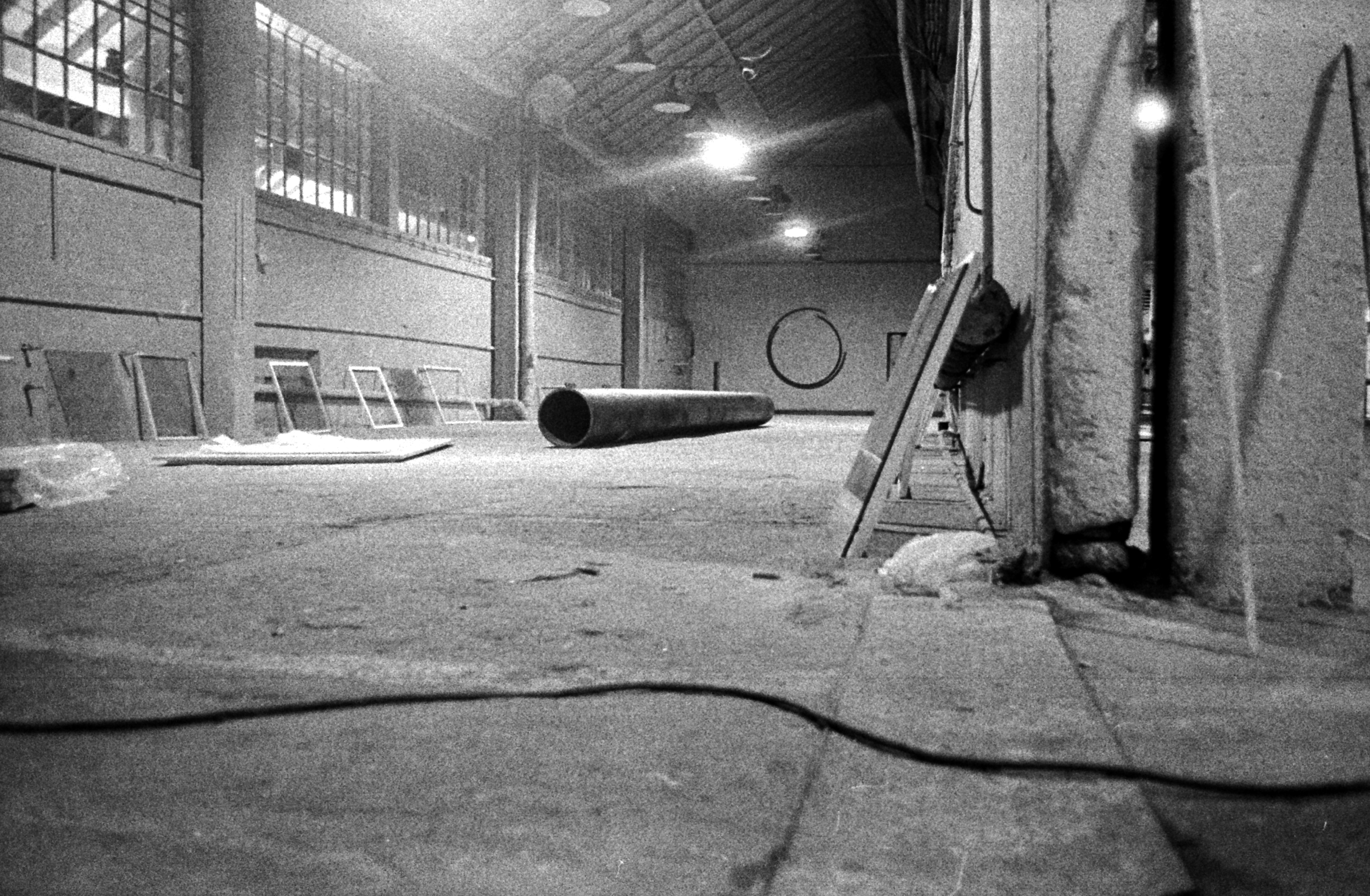
Wystawa Konstrukcja w procesie, 1981, fot. Jacek Kasprzycki
Considering Janusz Bogucki’s activity in terms of participation inevitably introduces a broader phenomenon of creating artistic and social community – an idea so vivid at the beginning of the 1980s. The question of moving away from shaping the social bond in culture typical for those times, to put it literally – “the politics cutting social ties” – is addressed by Bogucki, Turowski and Borowski in a report quoted in the introduction[36]. “Construction in Process” (“Konstrukcja w Procesie”) organised in Łódź in 1981, constitutes a particular case where there was no cooperation that the initiators and artists formed with workers, city authorities and “Solidarity” representatives. As pointed out by Aleksandra Jach, the key role of this artistic event was to visualise the process of creating objects, the revelation of different environments’ cooperation scheme of an assembly line[37]. Formally, the works represented the avant-garde constructivism tradition combined with minimalism. Though, as explained by the main initiator, Ryszard Waśka, it was the eponymous process, understood not only in the context of works’ creation but also in the entire logistics sphere, that mattered the most. Waśko stresses that the main idea of the project was to focus its organisation around artists and anyone willing to help in its accomplishment. The idea was not to turn to museum institutions or include formal structures or private investors in the process.
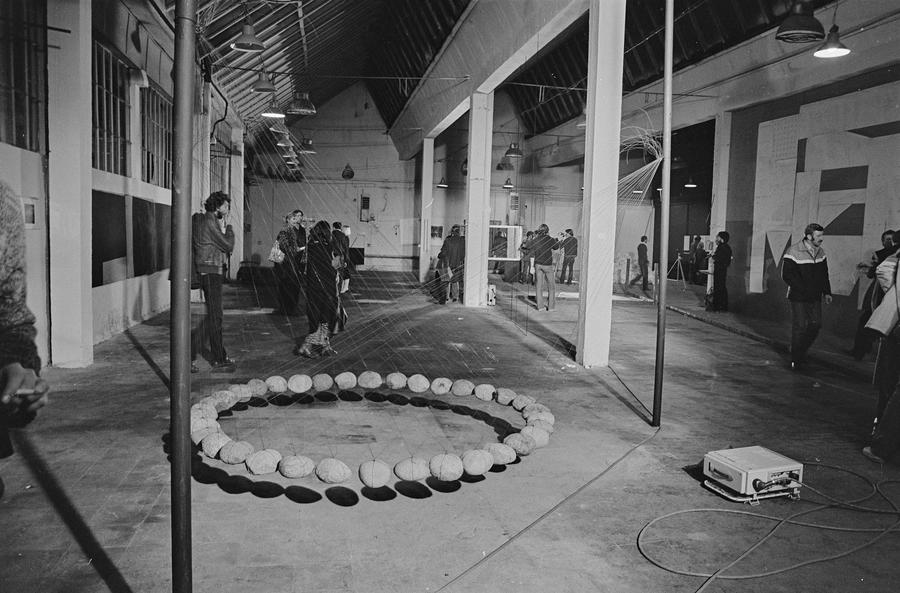
Wystawa Konstrukcja w procesie, 1981, fot. zygmuntrytka.pl, Fundacja Sztuki Współczesnej In Situ
The cooperation between artists, who would feel that they participate in social movement, and workers, who made their concept real and became co-authors in the process, played the key role in the enterprise. The abandoned Budrem factory hall was chosen as a place of joint work and future exhibition space. It was made available thanks to “Solidarity” intercession[38].
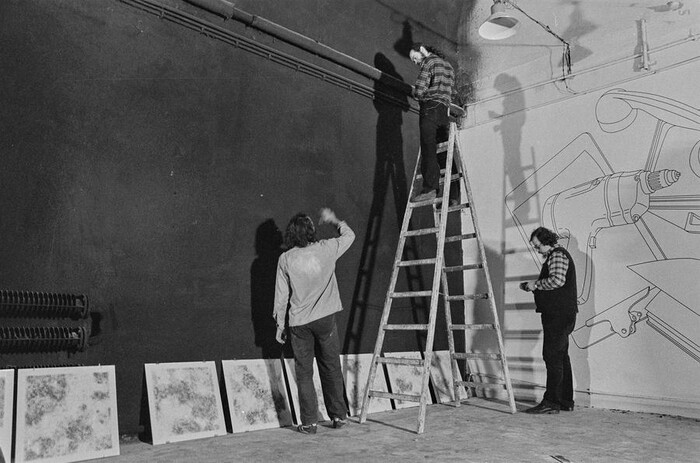
Wystawa Konstrukcja w procesie, fot. Zygmunt Rytka
When describing the “Construction in Process” profound genesis, Waśko reveals that he was inspired by London’s Hayward Gallery exhibition entitled “Pier+Ocean” where he showed his works. Most of the artists he met there, he invited by mail to participate in the execution of his concept later on. In order to have the grounds to involve foreign artists in the cooperation, Waśko created an unregistered fictional institution with its own logo and a name: “Modern Thought Archives” (“Archiwa Myśli Współczesnej”), based in his private apartment. The project with no external financing was facing incessant budget problems that were overcome solely thanks to determination of all people involved. Often because artists invited to participate in an exhibition covered the costs of accommodation themselves. Memoirs about preparatory period accentuate difficulties of gaining necessary materials or material processing to meet the requirements of making a lot of artistic works. Fortunately, supply warehouse and facilities workers were there to help, providing services after working hours[39]. A quite detailed report on “Construction in Process” programme, and elaborate reception of it, can be found in an analytical text by Anda Rottenberg. She wrote about the complicated system in which different connected groups ultimately accomplished the exhibition and its accompanying events. These took up six days in total and included: concerts, film reviews and a conference. The critic appreciated international personnel of artists renowned in the West, though not as famous in Poland, as well as a profoundly social character of this financed by joint effort initiative[40].
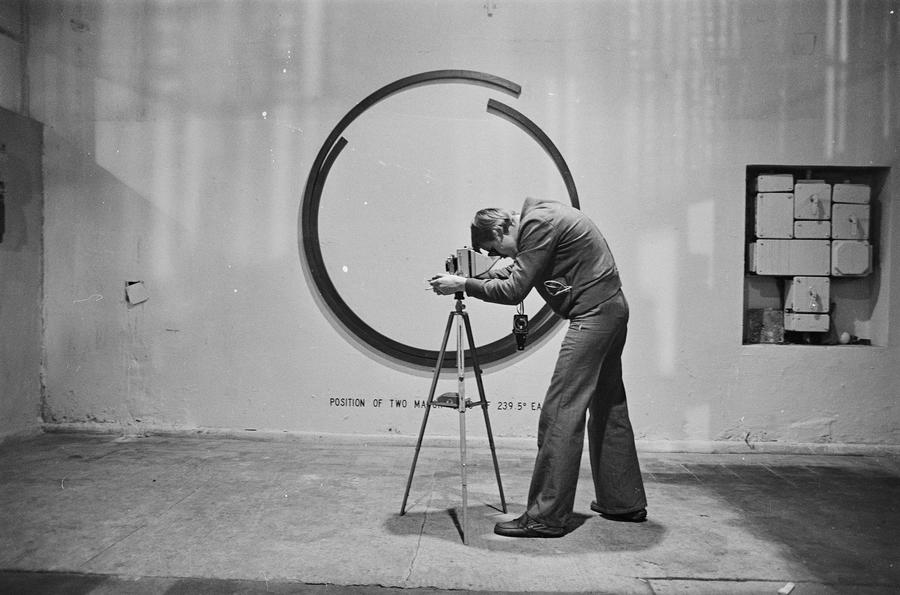
Wystawa Konstrukcja w procesie, fot. Zygmunt Rytka
Undoubtedly, “Construction in Process” can be considered a model implementation of practices seen abroad. Furthermore, given the conditions and the constant neccessity of working out compromises, it deserves even more admiration than just official funding – the institutional venture of the period.
Towards participatory utopia?
A characteristic tendency seen in the 1980s was artists forming various groups. The most significant ones were: “Koło Klipsa” from Poznań, „Gruppa” and “Neue Brieriemmiennost” from Warsaw, Wrocław’s “Luxus” or “Łódź Kaliska” from Łódź. To describe the activities of all groups above is to write a standalone article, yet for the purpose of this text, only the first two will be elaborated on. Together with 38 different groups of artists from a dozen countries, these two groups participated in a large, international exhibition in Kassel, 1987, entitled “Kunstlergruppen zeigen Gruppenkunstwerke” (“artistic groups present group works of art”). “Koło Klipsa” proposed a set of fairy-tale themed objects and staged characters made of artificial flowers elements, animals made of meshy material, dwarves formed of mud, or a huge moon hung above the remaining part of the exposition. Explaining their work method, the artists emphasised cooperative devising of creative formula by taking advantage of their individual traits and group discussions on combining individual creations into one, coherent concept. Leszek Knaflewski, a member of this group, noticed that upon developing the shared idea, each artists left an expression characteristic only for their individual style to enable a given artist’s identification. On the other hand, “Gruppa” decided to create a uniform and huge painting item (Kuda Gierman?) – several-metre-wide canvas, divided into smaller fields, each dedicated to a particular painter[41].
As much as Hamdi al Attar, the event’s curator, wrote about the social dimension of Poznań group, he also accused “Gruppa” of working in line with the capitalistic model. In his view, the artists suited more the art market standards, for example by being attached to the painting medium. The material status of “Gruppa” members was emphasised in equal measure, as they were significant university lecturers. As for the comment on their creative process, he criticised their distribution of roles deeming it not egalitarian enough. The curator and university of arts in Kassel professor in one person, in his participatory and collective philosophy postulated the introduction of a new genre – “collective piece of art”. The assumption to treat the piece as a symbol of joint work is reflected in the name of the project formation that he established – stoffwechsel (metabolism) – and it references particular artists’ actions as if they were organs in a properly functioning organism[42].
Aleksandra Alisauskas thinks that, in essence, both groups of Polish artists met the criteria to constitute the utopian vision of artistic community on the one hand, but on the other, they transformed the very idea. She observes a potential in the presented stance that might form a different way – one based on a combination of creative individuality participating in a collective activity. She also concludes how dangerous it is to reduce a unit to a group, even in this context, as it evokes objectification present in a totalitarian system[43]. A fitting example of Russian constructivists comes to mind, as it was their belief they would remain individualists by being of use to the authorities and promoting Communist ideas. Though when interpreting “Gruppa” participation in such a context, it is their work on a large-scale canvas placed next to a huge table that points to a different relation. The piece of furniture served not only to integrate the work, but it became a spot for communal meals, both for members of the group and creators from other foreign groups who were invited to sit there. Joint debates on the subject of art were supposed to lighten the tense atmosphere but, paradoxically, the organisers ultimately decided to remove the table[44]. This fact truly shifts the accent from a concept balancing on the verge of Communist utopia to lively idea of building artistic community through creative individualities.
Building common places
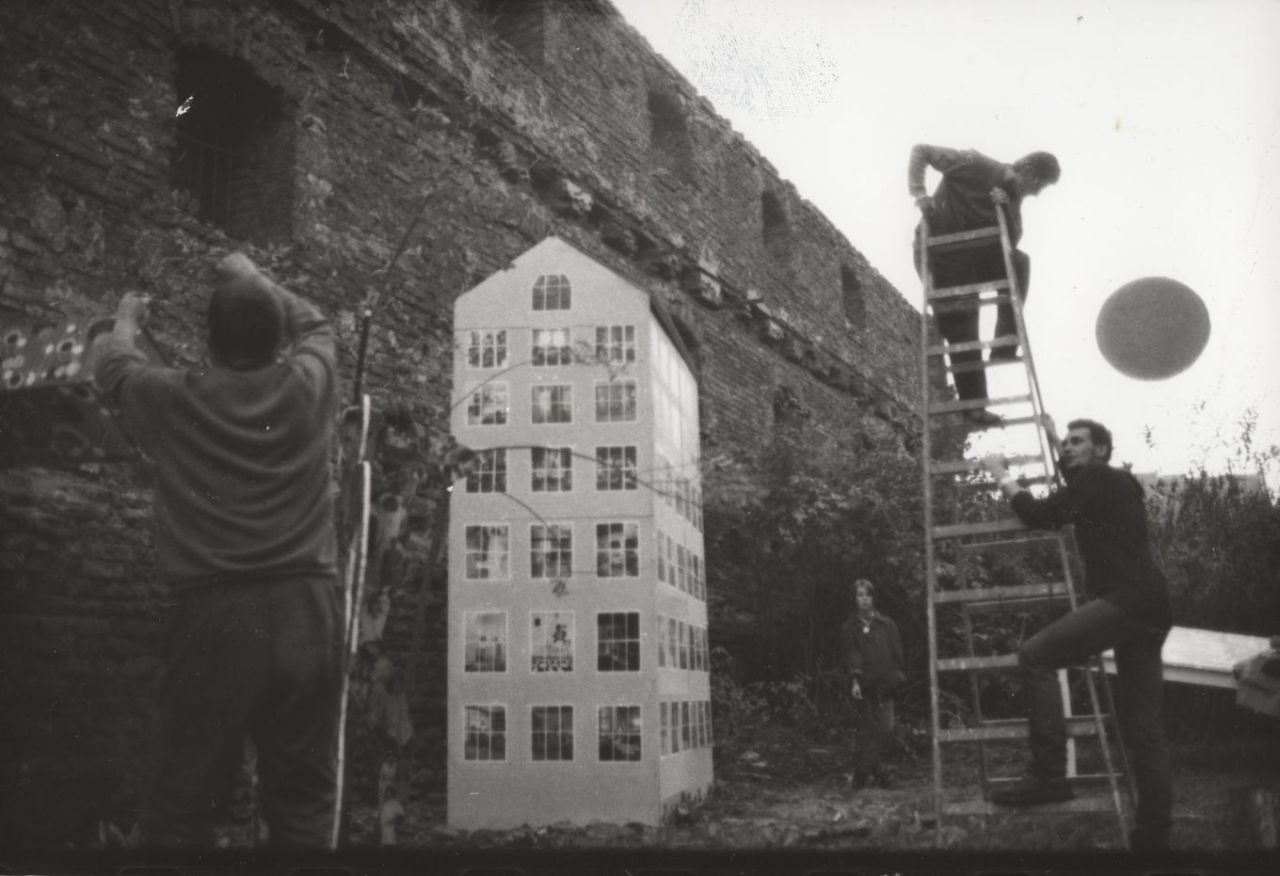
Montaż wystawy dyplomowej Kazimierza Kowalczyka, Wyspa Spichrzów, iswyspa.tumblr
The final point concluding the artistic collective creation beyond the time limitations of a single event was Gdańsk “The Isle of Granary” (“Wyspa Spichrzów”): its curation and its artistic life. Currently, the area is undergoing an almost total revitalisation. With many buildings that show the old suburban architecture, it is definitely a representative part of the city. Nevertheless, a large number of structures was in ruins many years after war and it was not before 1987, when a group of artists, Grzegorz Klamen being a prominent member of them, turned these derelict structures into space for artistic activity and a place for exhibition, albeit unofficially. A notable person for reactivation of this area was aforementioned Ryszard Ziarkiewicz, a history of art lecturer at the Academy of Fine Arts in Gdańsk, who greatly contributed to shaping the artistic community in Gdańsk focused around “The Isle of Granary” territory[45]. The idea of forming an artistic movement strictly related to a particular place is discussed in Grzegorz Klauman’s text entitled “The Reversed Archeology” (“Archeologia Odwrotna”) released two years earlier. The artist wrote about how he felt, both corporally and spiritually, the historical accumulation while performing creative work in that space. He describes a very personal experience and mentions the idea of artistic community made possible through relations between creators[46]. Apparently, a preview of his future plans.
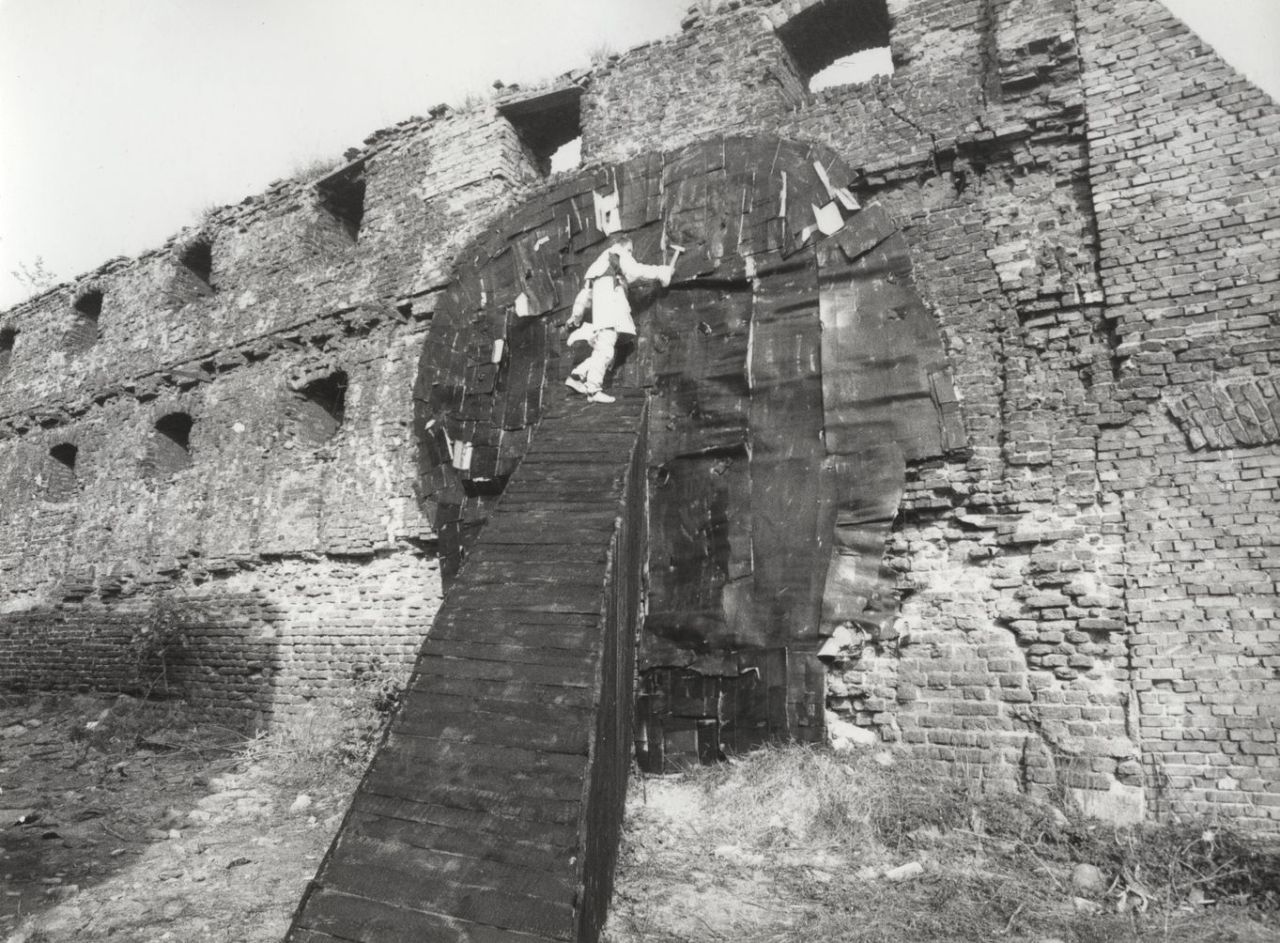
Grzegorz Klaman, Wielka Czarna Głowa, 1988, Wystawa teraz jest teraz, iswyspa.tumblr, archiwum isw
In time, an actual micro-community had truly formed on the Isle. Centered around exhibitions organised between 1987 and 1992 such as “Moby Dick” or “Now is now” (“Teraz jest teraz”), the works’ characteristic feature was their relation with space; a great example of which was Grzegorz Klaman’s “The Man with the Machinegun” (“Człowiek z karabinem”). A silhouette made of thin wooden planks that were placed on the floor amidst walls of ruined granary. The struggle to correlate the piece with the surroundings is reminiscent of exhibitions in the church of Divine Mercy, the Norblin factory or Budrem mentioned earlier. Various cities and artistic environments, though they are interlinked with shared ideals of the specific socio-historical situation.
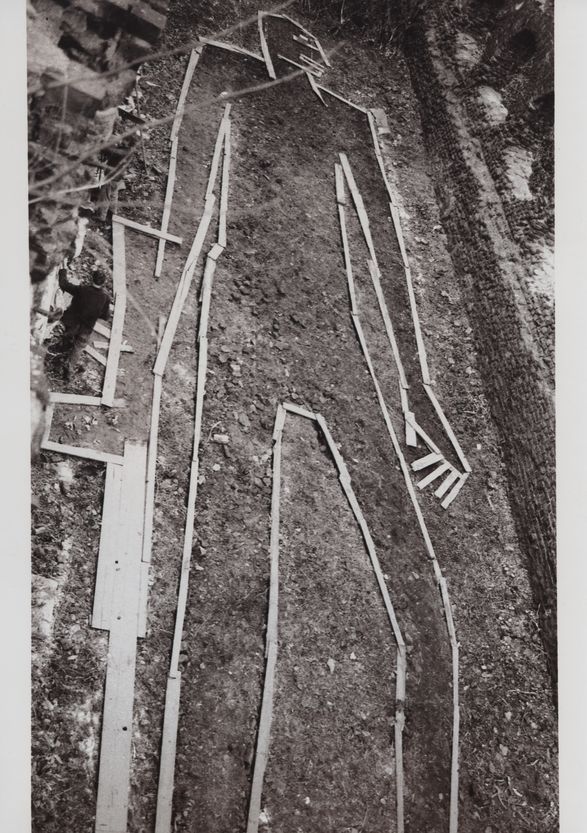
Kazimierz Kowalczyk, Człowiek z karabinem, wystawa Moby Dick, 1987
The phenomenon that connects different artistic formations of Polish art in the 1980s was the attempt to merge one’s creative individuality with cooperation fixed on reaching a greater goal. Based on the presented examples, one can notice a sense of participation in something relevant that reaches beyond fulfilling one’s ambitions and pursuing career. Moreover, it strongly transcends the naive belief in utopian socialism ideas made up of simple union slogans. Instead, it reflects the need that results from specific transitionary conditions. The hope and necessity for a socio-cultural reform is tangible among attitudes of various cooperating societies. It was this determination, as well as the premonition of transformation changes lying foundations for 1990s tendencies, that proposed completely different conditions for the way art world was to be shaped. Although, as a direct consequence of previous decade postulates
[1] K. Stanisławski, Młoda sztuka lat 80, “Student”, no. 7 1988, p. 9
[2] K. Stanisławki, Nie ma wyrazu, “Radar”, no. 32/4 1986.
[3] K. Załuski, Od nowej ekspresji do poeksrepsji, w: Ogólnopolska Wystawa Młodej Plastyki. Każdemu Czasowi jego sztuka-Arsenał 88, katalog, Warszawa 1988, p. 209.
[4] P. Sarzyński, U nas stracona dekada. A na świecie? Wyzwolona sztuka lat 80; Internet access at www.polityka.pl (access: 10.03.2022).
[5] The 80s. Art of the Eighties, Press release, Albertina Modern, 2021, p. 2-3; available at www.albertina.at (access: 12.03.2022).
[6] Ibidiem, p. 4; 10-11.
[7] Ibidiem, p. 5.
[8] J. Daszkiewicz, Malarstwo Młodych 1980-1990, Wydawnictwo Artystyczne i Filmowe, Warszawa 2006, p. 5.
[9] M. Rosiak, Nawrócenie na malarstwo, w: Ogólnopolska Wystawa Młodej Plastyki Każdemu Czasowi jego sztuka- Arsenał 88, catalogue, Warszawa 1988, p. 21.
[10] A. Betel, Szkic, in: Co słychać, catalogue, Warszawa 1984, p. 232.
[11] Initially, on rented computers.
[12] J. Czechowicz, Inauguracja działalności Centrum Sztuki Współczesnej, “Biuletyn Informacyjny P.P. Sztuka Polska”, no 4/1986, p. 3. However, only in 1988 a more significant breakthrough came in the form of the new exhibitions’ activities, unofficially initiated seminar as part of the International Art Seminar organised by Andrzej Mitan. Karol Sienkiewicz, Bez przysłowiowej pompy. Początki Centrum Sztuki Współczesnej i polityka kulturalna państwa, in: Utracone dziedzictwo…, p. 56.
[13] A liquidator of former ZPAP was established along with Liquidation Bureau. ZPAP’s assets. as written in “Kultura Niezależna”, that “had social ownership, was taken over by the state” [translated by Jakub Bujno] (p. 59).
[14] The above statement appeared in Visual Arts Department of Ministry of Culture and Arts report in 1983. “Biuletyn Informacyjny. Sztuka Polska”, no. 1–2 1984, p. 43.
[15] K. Czejarek, Raport o aktualnej sytuacji środowiska plastycznego, “Biuletyn Informacyjny. Sztuka Polska”, no 3 1984, p. 2.
[16] Barbara Zbrożyna, the last chairman of the Warsaw’s region union, concludes the situation: “ZPAP ended well”. Barbara Zbrożyna, Dyskusja o środowisku artystów, “Szkice. Pismo poświęcone problemom artystyczno-społecznym”, no. 8 1998, p. 10.
[17] The text was part of the report commissioned by Consultative Committee of Creators and Scientists Societies (in Polish: Komitet Porozumiewawczy Stowarzyszenia Twórczych i Naukowych – translator’s note). It was better known thanks to article publications under the altered title in Odra monthly: J. Bogucki, W. Borowski, A. Turowski, Sztuka i krytyka, “Odra”, no. 1 1981, p. 38.
[18] B. Klich, Co się stało z kulturą niezależną, “Tumult”, no. 5 1989, p. 20-24. This phenomenon was heavily criticised also by Piotr Piotrowski, who accused the artists involved of opportunism, turned from the state to the church, with the latter – according to him – “not differing from pseudo-avant-garde intellectual babble”; P. Piotrowski, Dekada. O syndromie lat siedemdziesiątych, kulturze artystycznej, krytyce, sztuce- wybiórczo i selektywnie, Poznań 1991, p. 76.
[19] W. Włodarczyk, Lata osiemdziesiąte- sztuka młodych, “Obieg”, no. 11 1990, p. 12.
[20] J. Daszkiewicz, Malarstwo młodych…, p. 10.
[21]A. Wojciechowski, Plastyka po 1981, in: Świadectwo wspólnoty. Katalog wystawy, Muzeum Archideicezji Warszawskiej, Warszawa 1986, p. 14 i 17.
[22] A. Sawicki, Krytyka nowa?, “Tumult” no. 4/1989, p. 49–51.
[23] J. Daszkiewicz, Malarstwo młodych…, p. 8-14.
[24] I purposefully avoid using the term “curator” in the text as it did not function formally in the eighties in Poland.
[25] R. Ziarkiewicz, Szkice, w: Realizm radykalny. Abstrakcja konkretna, katalog wystawy, Wydawnictwo Andrzej Bonarski, Warszawa 1990, p. 242.
[26] B. Rogulska, Stare i Nowe, “Kierunki”, no. 8 1988, p. 13.
[27] T. Rudomo, Abstrakcja i realizm (konkretnie), “Kultura”, no. 4 1988, p. 1
[28] P. Koziełowski, Co słychać, exhibition catalogue, M. Sitkowska (ed.), Wydawnictwo A. Bonarski, Warszawa 1989, p. 241.
[29] B. Rogalska, Stare i Nowe…, p. 14.
[30] Ł. Gorczyca, “Polski szyk” i klasa średnia. Działalność wystawiennicza Andrzeja Bonarskiego w latach 1986-1991, in: Odrzucone dziedzictwo. O sztuce polskiej lat 80, Muzeum sztuki nowoczesnej w Warszawie, p. 34; available online at www.artmuseum.pl.
[31] D. Jarecka, Janusz Bogucki. Odrzucony Szeeman, w: Odrzucone dziedzictwo. O sztuce polskiej lat 80, Muzeum Sztuki Nowoczesnej w Warszawie, p. 10-11, 17.
[32] Ibidiem, p. 18, 21.
[33] N.a Cieślińska, Spotkanie, “Przegląd Powszechny”, no. 10, 1983.
[34] H. Bukowski, Żytnia. Kto o tym pamięta?, “Biuletyn IPN” no. 1-2/2011, p. 74.
[35] D. Jarecka, op. cit., p. 13, 15.
[36] J. Bogucki, A.Turowski, W.Turowski, Raport o stanie krytyki, “Odra”, no. 1/1981, p. 42.
[37] A. Jach, „Konstrukcja w procesie” – wspólnota, która nadeszła?, in: Odrzucone dziedzictwo…, p. 137-138.
[38] Z Ryszardem Waśko rozmawia Bożena Czubak, Konstrukcja w procesie. Construccion in proces, Fundacja Profile, Warszawa 2020, p. 9-10, 20.
[39] Ibidiem, p. 12, 14, 24.
[40] A. Rottenberg, Łódzkie Rondo Artystyczne, “Kultura”, no. 50 1981, p. 11.
[41] A. Alisauskas, Komuniści tacy jak oni. Polskie grupy artystyczne na wystawie “Künstlergruppen zeigen Gruppenkunstwerke” p. 125-128.
[42] H. el Attar, Kunstlergruppen und die Ausstellung in K18, in: Kunstlergruppen zeigen Gruppenkunstwerke, ed. Idiem, Kassel 1987, p. 1-2, 18.
[43] A. Alisauskas, op. cit., p. 131, 136.
[44] R. Woźniak, Kuda Gierman czyli wybryk geniusza na zatłoczonej ulicy w godzinie szczytu, “Oj dobrze już”, no. 7, 1988.
[45] D. Kuryłek, M. Tatar, Teraz jest teraz. Artyści i gdańska Wyspa Spichrzów, w: Odrzucone dziedzictwo…, p. 174.
[46] Tekst w pierwotnej wersji stanowił część jego pracy dyplomowej, ale później był kilkukrotnie włączany jako część większych publikacji. Zob. G. Klaman, Archeologia odwrotna, in: K. Gutfrański, “Klaman”, Instytut Sztuki Wyspa, Gdańsk 2010.


